Page 624 - Read Online
P. 624
Wilgus. Plast Aesthet Res 2020;7:54 I http://dx.doi.org/10.20517/2347-9264.2020.150 Page 3 of 18
generally limited to experiments on tissue from human patients. A number of studies have examined
inflammation in keloid tissue and the vast majority have indicated that keloids are associated with an
increase in pro-inflammatory mediators and inflammatory cells.
Several studies have suggested an increase in pro-inflammatory mediator expression in keloids. A study
[14]
by Zhang et al. suggested that a pro-inflammatory niche exists in keloids, based on observations that
interleukin (IL)-6 and IL-17 were increased in keloid tissue compared to normal skin. Another group
reported an increase in chemokine-like factor 1 and other pro-inflammatory cytokines, such as IL-6, IL-8,
[15]
[16]
and IL-18, in keloid tissue compared to normal skin and normal scars . Jumper et al. performed a site-
specific gene expression profiling study and found that keloid tissue was enriched for pro-inflammatory
genes and pro-inflammatory signaling pathway members, including IL-1β, IL-8, and IL-17, among others.
Interestingly, the data pointed to a possible role for the overlying epidermal cells in keloid lesions in the
regulation of inflammation.
In addition to pro-inflammatory mediators, several inflammatory cell types are prominent in keloids,
particularly mast cells and macrophages. A study by Dong et al. suggested that the total number of mast
[17]
cells and the number of mast cells expressing chymase, a serine protease found primarily in mast cells,
are higher in keloid tissue compared to normal skin. An increase in chymase activity in keloids was also
[17]
observed, and chymase was shown to stimulate collagen production in cultured fibroblasts . Another
study found a low number of mast cells expressing tryptase, another mast cell-related serine protease, in
keloids compared to tissue from several other organs; however, the sample size was small (n = 3 keloids)
and there was no direct analysis of or comparison to normal skin . Several studies have also shown an
[18]
[21]
increase in macrophages in keloids compared to normal skin [19,20] . A study by Shaker et al. showed that
both macrophages and mast cells are frequently found in close proximity to fibroblasts in keloid tissue,
[22]
and another study by Arbi et al. showed a close association between mast cells and fibroblasts in keloid
samples by transmission electron microscopy. Although these studies were limited in scope, they do
suggest the possibility that direct cell-cell interactions between inflammatory cells and fibroblasts could be
important for fibrosis.
[23]
A more comprehensive analysis of inflammatory and immune cells was performed by Bagabir et al. In
this study, the number of mast cells and degranulated (activated) mast cells were found to be increased in
keloids compared to normal skin and normal scar tissue, as were the number of M1 and M2 macrophages.
M1 (classically activated; pro-inflammatory) and M2 (alternatively activated; anti-inflammatory/pro-
fibrotic) macrophages express different biomarkers, and this general classification system is commonly used
[24]
to delineate different macrophage phenotypes . Interestingly, inflammatory cell enrichment was more
closely associated with intralesional and perilesional keloid sites as opposed to extralesional sites.
While most published studies indicate an increase in mast cells and macrophages in keloid scars, one
study comparing human keloids and equine exuberant granulation tissue (a fibrotic condition suggested
to have some similarities to human keloids) reported minimal mast cells and macrophages in both fibrotic
[25]
conditions . Two other studies suggested either minimal differences or fewer mast cells in keloids [26,27] .
While the reasons for the discrepancies between the studies are not entirely clear, the observations by
[23]
Bagabir et al. described earlier showed that the number of inflammatory cells varied across different
sites within a keloid lesion. Also, in some of the studies, granule markers were the sole staining method
used, which could underestimate the number of mast cells if they have degranulated. Therefore, the specific
locations at which the cells were quantified, in addition to differences in staining methods, sample sizes,
and patient populations, could contribute to the inconsistent results.

